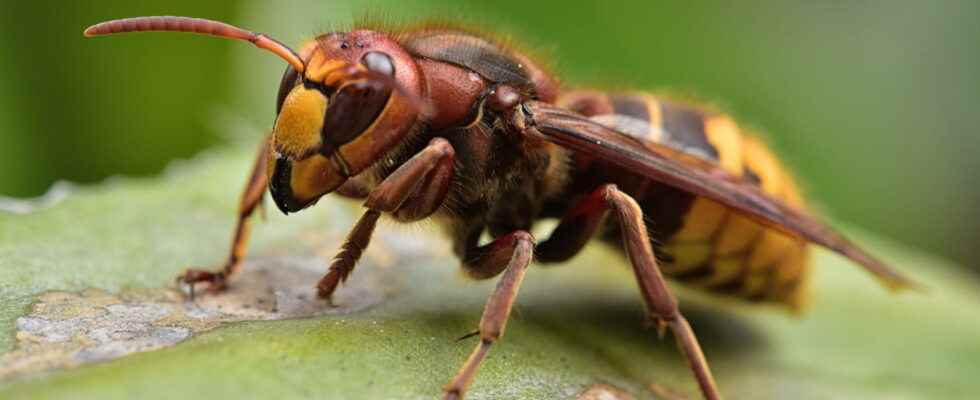Stung by hornets during a walk in the forest on Sunday August 21, three cyclists were hospitalized near Roanne (Auvergne-Rhône Alpes). The sting of hornets (European or Asian) often results in swelling of the affected part. The main risk is allergy. Explanations and advice with Tina Gereral, pharmacist.
[Mise à jour le 22 août 2022 à 08h53] Three cyclists were bitten by hornets during a bike ride on Sunday August 21 in Briennon near Roanne (Auvergne-Rhône-Alpes). Two men, 51 and 72, were bitten fifty times and the third person, stung fifteen times, was also hospitalized, reports France Blue Saint-Etienne Loire. “There is no such fortuitous attack of fifty hornets, reassured Bertrand Dufour, manager of the Loire wasp company. They feel in danger if you hunt them yourself or when you are near the nest. For instance, you set foot next to a nest without having seen it, it vibrates and then they come out to sting you. Or a nest fell with the wind in the forest and these cyclists were nearby due to bad luck.” It is with the arrival of spring (April/May) that the european hornet (Vespa Crabro) and Asian (Vespa Velutina) is back in France. The sting hornets often results in a swelling of the affected part of the body but are not usually not fatal. They are dangerous for allergy sufferers. How recognize a hornet and its sting? What to do in case of a sting and what to put on it for cure rapidly ? Can we die from a hornet sting? How to avoid to get bitten?
Why does a hornet sting?
A hornet does not sting for no reason. He attacks to defend himself when it feels threatened or if its nest is disturbed. When he sees an intruder approaching his nest, he becomes very aggressive and may sting what he considers an intruder. Its venom contains enzymes, peptides, amines and amino acids that cause a reaction, more or less intense, depending on the amount of venom injected. A single sting can be painful, but mostly not serious.
The European hornet looks like a waspbut its size is 3 times bigger. Its body is covered with red, black and yellow spots. Its abdomen is striped black and yellow and the noise it makes during its flight is loud. The Asian Hornet has a black thorax and yellow leg tips.
The intensity of the reaction depends on the amount of venom injected during the bite. Locally, a reaction appears quickly with swelling which is accompanied by itching. In addition, some people may suffer from vomiting, headaches or a drop in blood pressure. “In the most severe cases, the hornet sting can lead to an allergic reaction with anaphylactic shock followed by Quincke’s oedema”, continues our interlocutor.
The main risks of a hornet sting are anaphylactic shock and angioedema
Is a hornet sting dangerous?
In the event of a hornet sting, the main risk remains the allergic reaction. It is the enzymes contained in the venom that lead to the formation of immunoglobulins (igE) responsible for allergic reactions in some people. “Often, when it comes to a first sting the victim does not know if he is allergic to hornet venom“, points out Tina Gereral. The main risk remains anaphylactic shock and angioedema. If appropriate treatment is not implemented very quickly, the victim may die.
Can you die from a hornet sting?
“For people who are highly allergic to venom, the sting can be fatal“, details Tina Gereral, pharmacist. Obstruction of the respiratory tract and cardiovascular shock can indeed lead to the death of the victim.
To relieve the pain triggered by the sting, it is recommended:
► Approach a heat source (hair dryer, cigarette), by avoiding burning yourself, can reduce the pain.
► Disinfect with soap or an antiseptic as this often causes a small local infection.
► Whether allergic reactioncall urgently 15. Symptoms can be hives, redness, itching, generalized swelling, edema of the tongue or respiratory tract (chest pressure, cyanosis = bluish coloring of the skin), drop in blood pressure, dizziness, nausea, vomiting, diarrhea.
► If sting in the mouth, throat, multiple stings (more than 20) or if local symptoms worsen, consult a doctor urgently.
The other cases are painful but generally not serious.
“If the sting occurred on the hand, remove rings and bracelets so as not to impede blood circulation if swelling develops. Monitor for 48 hoursin case of persistence of symptoms a consultation is essential“, recommends the pharmacist. In the event of a moderate allergic reaction, you can take a antihistamine tablet (Zyrtec® for example) to reduce swelling.
In all cases, the following signs should lead to an emergency consultation (call 15):
► If the local reaction (swelling, pain, redness) worsens in the days following the bite
► If fever, nausea, vomiting and chills occur.
► If you have difficulty breathing
► If you pass near a hornet’s nest, do not panic so as not to excite it.
► Move away without abrupt gesture, if a hornet approaches do not fidget with big gestures, avoid disorderly movements, gently push him back.
► Avoid perfumes and creams whose smell may attract them.
► Prefer light colors.
► During the summer, remember to close bottles and cans of sugary drinks that attract hornets just like food.
“Do not attempt to dislodge a nest and call in the professionals!“, recalls Tina Gereral.
What is the difference between the sting of an Asian hornet and that of a European hornet?
The sting of the Asian hornet can be more painful than that of the European hornet. However, it is not more dangerous.
Thanks to Tina Gereral, pharmacist.
